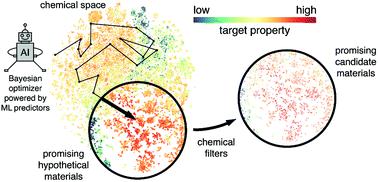当前位置:
X-MOL 学术
›
Mater. Horiz.
›
论文详情
Our official English website, www.x-mol.net, welcomes your
feedback! (Note: you will need to create a separate account there.)
Machine-learning-assisted search for functional materials over extended chemical space
Materials Horizons ( IF 12.2 ) Pub Date : 2020-08-04 , DOI: 10.1039/d0mh00881h Vadim Korolev 1, 2, 3, 4, 5 , Artem Mitrofanov 1, 2, 3, 4, 5 , Artem Eliseev 5, 6, 7, 8, 9 , Valery Tkachenko 1, 2, 3, 4
Materials Horizons ( IF 12.2 ) Pub Date : 2020-08-04 , DOI: 10.1039/d0mh00881h Vadim Korolev 1, 2, 3, 4, 5 , Artem Mitrofanov 1, 2, 3, 4, 5 , Artem Eliseev 5, 6, 7, 8, 9 , Valery Tkachenko 1, 2, 3, 4
Affiliation

|
Materials discovery is a grand challenge for modern materials science. In particular, inverse materials design is aimed at the accelerated search for materials with human-defined target properties. Unfortunately, this is associated with various obstacles, such as incremental improvements of known compounds, unreported properties of synthesized materials, and chemically plausible “missing compounds.” A machine-learning-based approach using unified compositional–structural representations is proposed to overcome the issues mentioned above. The validity of the proposed method has been approved by searching for functional materials—some previously known phases were “re-discovered.” In addition to well-known superhard compounds, unconventional structures that have never been considered in this context were also presented. Analysis of the generated populations provided insights into the underlying quantitative structure–property relationships. This data-driven approach can be successfully applied to discover materials with arbitrary functionalities given a reliable experimental/computational database for the target property.
中文翻译:

机器学习辅助在扩展的化学空间中搜索功能材料
材料发现是现代材料科学的巨大挑战。特别地,逆向材料设计旨在加速寻找具有人类定义目标特性的材料。不幸的是,这伴随着各种障碍,例如已知化合物的逐步改进,合成材料的未报告性质以及化学上合理的“缺失化合物”。为了克服上述问题,提出了一种使用统一的成分-结构表示法的基于机器学习的方法。通过搜索功能材料已经证实了该方法的有效性-“重新发现”了一些先前已知的阶段。除了众所周知的超硬化合物外,还介绍了在此情况下从未考虑过的非常规结构。对产生的种群的分析提供了对潜在的定量结构与属性关系的见解。这种数据驱动的方法可以成功地用于发现具有任意功能的材料,并为目标特性提供可靠的实验/计算数据库。
更新日期:2020-10-05
中文翻译:

机器学习辅助在扩展的化学空间中搜索功能材料
材料发现是现代材料科学的巨大挑战。特别地,逆向材料设计旨在加速寻找具有人类定义目标特性的材料。不幸的是,这伴随着各种障碍,例如已知化合物的逐步改进,合成材料的未报告性质以及化学上合理的“缺失化合物”。为了克服上述问题,提出了一种使用统一的成分-结构表示法的基于机器学习的方法。通过搜索功能材料已经证实了该方法的有效性-“重新发现”了一些先前已知的阶段。除了众所周知的超硬化合物外,还介绍了在此情况下从未考虑过的非常规结构。对产生的种群的分析提供了对潜在的定量结构与属性关系的见解。这种数据驱动的方法可以成功地用于发现具有任意功能的材料,并为目标特性提供可靠的实验/计算数据库。











































 京公网安备 11010802027423号
京公网安备 11010802027423号